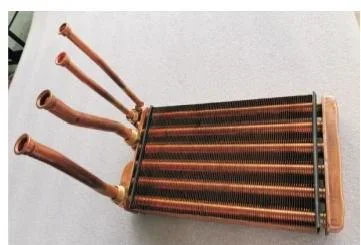Wall furnaces are an efficient and space-saving heating solution for residential and commercial spaces. These heating systems rely on a main heat exchanger to transfer heat from the combustion process to the surrounding air. In this blog post, ISAAC will share the features of wall furnace main heat exchanger for sale, exploring their functionality, design, and advantages.
1. Functionality of Wall Furnace Main Heat Exchangers
The main heat exchanger in a wall furnace plays a vital role in the heating process. Its primary function is to transfer heat from the combustion chamber to the surrounding air, ensuring efficient and effective heating throughout the space. As the fuel burns, the heat exchanger absorbs the generated heat and transfers it to the air passing through the system.
The heat exchanger consists of a series of tubes or coils that are strategically placed within the furnace. These tubes or coils are typically made of high-quality materials such as stainless steel or copper, known for their excellent heat conductivity and durability. The design of the heat exchanger maximizes the surface area available for heat transfer, allowing for optimal efficiency.
2. Design Features of Wall Furnace Main Heat Exchangers
a. Tubular Heat Exchangers:
One common design of wall furnace main heat exchangers is the tubular heat exchanger. This design consists of a series of interconnected tubes that create a labyrinth-like structure. The combustion gases flow through these tubes, while the air to be heated passes over the exterior surface of the tubes. This design maximizes the contact between the hot gases and the air, facilitating efficient heat transfer.
b. Finned Heat Exchangers:
Another popular design is the finned heat exchanger. In this configuration, the heat exchanger tubes have fins attached to their exterior surface. These fins increase the surface area available for heat transfer, enhancing the overall efficiency of the system. The fins also help to distribute the heat more evenly, ensuring consistent heating throughout the space.
c. Counterflow Heat Exchangers:
Counterflow heat exchangers are designed to optimize heat transfer by allowing the combustion gases and the air to flow in opposite directions. This design ensures that the coldest air entering the heat exchanger comes into contact with the hottest gases, maximizing the temperature difference and improving heat transfer efficiency.
d. Compact and Space-Saving Design:
Wall furnace main heat exchangers are specifically designed to be compact and space-saving. Their size and shape allow for easy installation in limited spaces, making them ideal for apartments, small homes, and commercial buildings where space is a premium. Despite their compact design, these heat exchangers are engineered to provide efficient and effective heating performance.

3. Benefits of Wall Furnace Main Heat Exchangers
a. Energy Efficiency:
Wall furnace main heat exchangers are designed to maximize energy efficiency. By effectively transferring heat from the combustion process to the air, these heat exchangers minimize heat loss and ensure that the energy consumed is converted into useful heat. This efficiency not only reduces energy consumption but also lowers heating costs for homeowners and businesses.
b. Improved Indoor Air Quality:
The main heat exchanger in a wall furnace acts as a barrier between the combustion gases and the indoor air. This separation prevents the release of harmful byproducts, such as carbon monoxide, into the living or working space. With proper maintenance and regular inspections, wall furnace main heat exchangers contribute to improved indoor air quality and the overall safety of the environment.
c. Even and Consistent Heating:
The design of wall furnace main heat exchangers, particularly the finned heat exchanger, ensures even and consistent heating throughout the space. The fins distribute the heat more evenly, eliminating cold spots and providing a comfortable environment. This feature is especially beneficial for larger spaces where maintaining a consistent temperature can be challenging.
d. Durability and Longevity:
Wall furnace main heat exchangers are built to withstand the demands of continuous heating. The use of high-quality materials, such as stainless steel or copper, ensures their durability and longevity. With proper maintenance and regular servicing, these heat exchangers can provide reliable heating for many years, making them a cost-effective investment.
Conclusion
Wall furnace main heat exchangers are essential components of efficient heating systems. Their functionality, design features, and associated benefits contribute to optimal heating performance, energy efficiency, improved indoor air quality, and long-term durability. Understanding the key features of these heat exchangers allows homeowners and business owners to make informed decisions when selecting a wall furnace for their space. By investing in a high-quality wall furnace with a reliable main heat exchanger, individuals can enjoy the comfort and warmth they desire while minimizing energy consumption and maximizing cost savings.
https://www.isaacoutlets.com/Features-of-wall-furnace-main-heat-exchanger.html
ISAAC
975386094@qq.com

